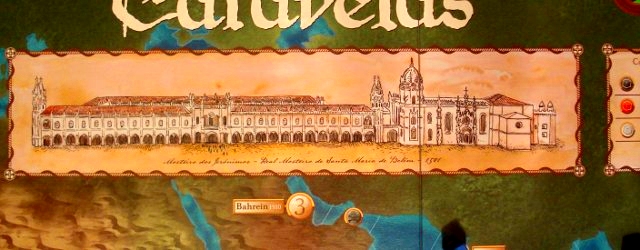| Strategy | Luck |
|---|---|
| Interaction | Components & Design |
| Complexity | Score |
This review turned out to be one of the harder ones to write. When I have a game that everyone agrees rocks, the review isn’t too hard to write. If the game is abysmal, then obviously it’s not as much fun to write about it – for me, at least – but still it’s not hard. But then there is the games that I really wanted to like: they are beautiful, they have innovative ideas, but for some reason they just don’t click. Today we have one of those, which is why the review has been floating around since Essen last year and didn’t go anywhere.

Caravelas is a game about the Portuguese era of exploration in the 15th century, when sailors from the south-western corner of Europe where among the first to go to far-away places, discover new land and bring home exotic goods. We’ll follow in their footsteps and take our small fleet of caravels all around the Atlantic and Indian ocean in search for adventure and profit.
All players start with their caraveeple (That’s a caravel meeple. I promise I won’t use the word much) in Lisbon, four to seven cards in hand (only on the first turn, later it’s five for everyone) and player tableau with three ships, all empty at this point, and nine navigation markers in front of them. These navigation markers have two uses: they move your ship around and are also used to bid for turn order. The player bidding most markers may choose first in which position he wants to go, then the player with second-most and so on. Even if you didn’t win the auction, the markers you bid are spent for this round. This system has some confusing implications which, as always, we promptly ran into as early as our first game: the manual states that if no one bids, turn order remains the same. But what happens when two people out of four bid? Those two may choose their position, which obviously includes the position taken by the two non-bidders – but then, what happens to them? Do they get pushed, and if so where? And what happens if the other player that bid is standing in the space they would be pushed to? Of course, this situation is easily house-ruled, but we had to spend some time discussing it before we could proceed.
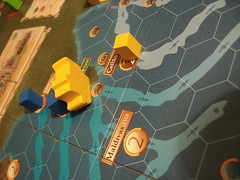
Once turn order is determined, every player takes their turn and then the new order is auctioned again. On their turn, players can spend navigation markers to move one hex on the map per marker – so if you bid high for turn order, you have less moves available. Travelling that way would be excruciatingly slow, but fortunately there is a much faster way: many places on the map are marked with beneficial winds and currents. As long as you follow these in the right direction, your moves are free. Only when you leave the currents do you have to pay your moves. Given that the board is covered in these currents, you can travel quite a remarkable distance in only one turn.
Along the way, there is a few things you will run across: the first is cities – or maybe colonies to be founded. The first player to reach a city can place their discovery marker there and immediately receives from one to three victory points, more points the further from Lisbon the discovered city is. Also, at the end of the game players receive five additional points for every city they discovered that was in their discovery cards. Most cities become uninteresting once they are discovered, but there is some exceptions; eight cities on the map are marked in colour, and every player to get here can load one corresponding cargo cube on their fleet: chilli peppers, Brazil wood, ivory, pepper, cinnamon, silk, silver and nutmeg. Your little fleet can only load one cube of each colour – except nutmeg and silver that you cannot carry before upgrading your fleet. There is four cubes of every colour, so there is never a shortage of anything. Discovering and taking on cargo happens en passant, you don’t need to spend a navigation marker on it.
Besides cities, there is three kinds of dots on the map: red dots, blue dots and pirate dots. The rules tell us that things happen when you cross those dots – nice and well in the middle of your turn, but what happens when you start or end your turn on one of these? Again after some discussion we decided that effects happen when you enter the hex with the dot, but the rules could have been clearer. When you enter a hex with a pirate dot, you must pay an additional navigation marker, even when following a current. On a hex with a red dot, you roll the dice; there is a 50% chance that one of your ships will just sink, losing the ship until and all the cargo on it until you get back to Lisbon to buy a new one – this seems harsh, but fits thematically: all red dots are around the Cape of Good Hope, one of the most dangerous areas of the seas at the time. You also have a good chance to avoid red dots altogether by making good use of the blue ones.When entering a hex with a blue dot, you must play an event card from your hand. Some of them are beneficial, some not so much. Green Good Winds restore two of your navigation markers or can be played on a pirate dot to avoid paying the additional navigation marker. Yellow Storms indicate a direction and move your ship two hexes that way; this makes yellow Storms the most useful cards in the game in many situations, because you are not affected by dots on the hexes you cross with a storm. Conveniently, the red dots at the Cape of Good Hope are surrounded by blue dots, so you usually have a chance to cross the red dots with a card and not risk losing a ship. On the bad end of the card spectrum there is red cards that are unfortunately also called Storms but cost you up two four navigation markers and the dreaded Dead Calm that immediately ends your turn if you have to play it.
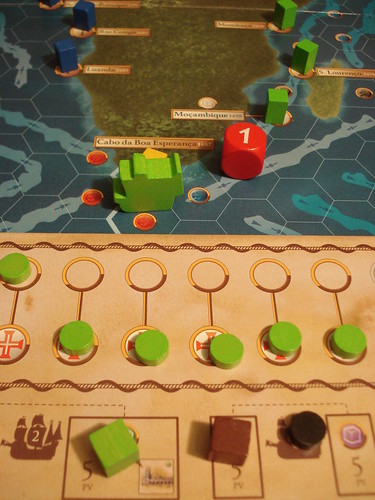
All event cards share one side effect: all other players on the same ocean as you – separated by a line at Cape of Good Hope – may gain a bonus move when you play them. In case of a yellow Storm they can choose to follow the winds in the same direction, in the case of Good Winds or a red Storm they may move up to the number of hexes that is given on a card. These bonus moves also carry them across any dots on the map, but it is still possible to discover cities and load goods. So you end up helping your opponents most times you play an event. Worse, the other player’s bonus move goes before your move with the event card. If their fleets are close to you, that may mean they discover a city just before you can.
Once you discovered some cities and loaded your ships with valuable goods, you may find yourself back in Lisbon. If you decide to stop here, your turn ends and you sell all your goods – you cannot sell just some of them. Nutmeg and silver are worth ten points each, all the others are worth five. You can, instead of gaining points for them, spend three goods cubes to upgrade your fleet from old-fashioned caravels to more modern naus (now I’m glad I didn’t use caraveeple more – I would have to call the upgrades ships nauseeple, and that sounds just bad). In game terms, having your fleet upgraded means you gain three more navigation markers and can now carry silver and nutmeg. When selling goods, pepper is special. You can decide to donate the profit from selling it to the construction of the Jeronimos Monastery. The Monastery – a World Heritage Site in the real world – serves to end the game: there will always be one piece more to build than there are players, and when it is completed, the game ends. But as a reward for contributing to the Monastery, each piece you funded is worth ten points instead of five for just selling the pepper.
As I wrote in the beginning, I’m in two minds about Caravelas. There is some things I genuinely like: the setting, for one, is great, I always enjoyed everything to do with the age of explorers. The material is another thing: Caravelas looks very good. There is more “mapwork” than artwork, but I can look at Caravelas and say that it’s a pretty game. I also like the fact that there is some historical information on each of the destination cards but it doesn’t bash my head in with being educational. Last, but not least, the ideas used are good: bidding for turn order with the same points you need for movement is only a little thing, but it forces you to make interesting decisions. Having the event cards give a bonus move to the other players is a good part, too: it forces you to consider which card benefits you more than them, and it keeps the other players involved during the somewhat long turns. And making movement along the currents free is an easy to way to speed up the long travels.
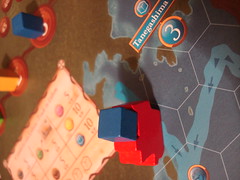
But at least for me, the good ideas don’t blend together into a great game. The event cards introduce a very big element of luck into the game; being stuck at the Cape of Good Hope with no cards that would take you in the right direction basically means that you lose the turn and can lose the game for you. After all, someone with better cards can go all the way to China and back in only four turns, maybe even three. So losing one turn is a big deal. In the same vein, ending your turn just short of Lisbon can lose the game for you, since your turn ends there if you want to unload. So on your next turn, you take one action and lose the rest of the turn. Travelling with the help of winds and currents opposed to travelling under your own power is such a big difference in speed that it feels disjointed: you can travel one hex for one marker, or you can go halfway around the world for free. Most of the cities become completely irrelevant once discovered. Except for the cities where you load goods, there is no reason ever to return to them. It is also very hard to catch up to someone that has a lead on you since, unless his cards are much worse than yours, he will make the same points you make in the same time – and trying to extend the game by not building the monastery doesn’t help either: not only is your opponent still moving at the same speed, he also gets more points than you for building the monastery.
All this adds up to two problems I had with Caravelas. First, the timing feels weird.You have a rush phase at the beginning where everyone tries to discover their destinations in the Atlantic and western Indian ocean. Then, after the first stop back home in Lisbon you have another rush to be the first to complete a full circle of the Indian ocean with your now upgraded fleet, because the first one to do usually wins. But those two parts feel like they are not connected, you are doing completely different things. Second, and worse, there is not much strategic choice. You have some tactical options with your event card – except when you don’t because of bad luck – but in the end they come down to covering the biggest distance that you can. And strategically, you decide if you turn around behind Mombassa to upgrade your ship early on the first circuit or if you go on to Macao and Calcutta to load Silk and Pepper for ten more points. We’re still discussing if not upgrading your fleet and taking the 15 points for the cubes instead can be a viable strategy – on the one hand it’s a good thing that it’s not an obvious choice, but on the other hand, that one choice still doesn’t open many more strategies. And if you decide to upgrade, going the long route to the Moluccas and Tanegashima is reasonably the only thing to do: you have to catch up 15 points you just spends, loading cargo there is twenty points, and since the upgrade also gives you three more navigation markers you can do it in the same number of turns, if Fortuna smiles on your cards.
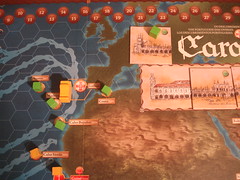
Finally, the rulebook is not helping. Some information is just not in there or is ambiguous and leads to discussions during the game. You already saw some examples above, but the biggest one that we had to have a duel to the death over in the middle of the game is: can you unload your cargo in Lisbon if you get there with your bonus move on another players turn? Because unloading ends your turn, so if you arrive there but can only unload on your turn, that means you lose a turn. And you don’t want that.
Caravelas was one of the games I was really looking forward to at Spiel 2010, so maybe my review is coloured by my great expectations. But my sentiment is that Caravelas is a good-looking game with good ideas that does not live up to it’s potential.

